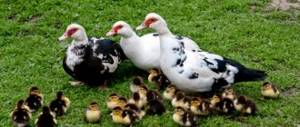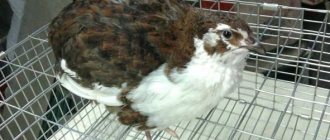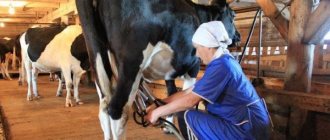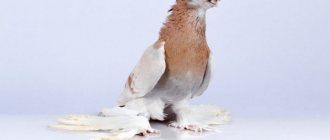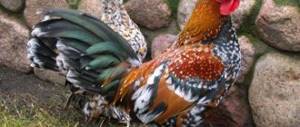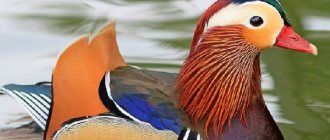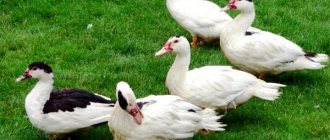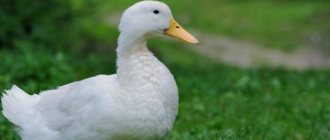Appearance
In color, Texans resemble English ones, but it is preferable for them to have no black spots on the body; no more than 3 are allowed. Every bird must have a spot on its head.
Texas quail laying hens should have pink bills - this is not only a sign of the breed, but also of health.
Anything that does not fit these characteristics is excluded from breeding.
The body shape is round, almost spherical. The legs stand out noticeably, the breast is well muscled and wide. These are the largest representatives of quails; they stand out when kept in mixed conditions, being almost 1.5 times larger than Japanese and Estonian ones.
Character
These are very calm, slow birds. Even day-old young animals jump and move around in the cage a little. Adults, even experienced farmers, often amaze with moderate activity; they make much less noise, which makes them more convenient to keep in an apartment.
Thanks to its excellent character, you can add its miniature relatives to the Texas quail without fear.
Reviews from Texas White owners
Roman Kirillov, p. Snezhnoye
We took Texas White and Pharaoh quails for comparison to figure out which is better to raise for meat. Texans are good because they are very calm, the pharaohs are more hectic. To account for feed consumption, they were fed the same food, but from different bags. The number of bags was recorded. As a result, half a bag of feed was saved on the pharaohs. The quails were almost the same in weight, but the white ones seemed larger. As far as I know, white always visually increases the size of an object.
Olga Evgenievna Torbeeva, Kirov
I keep Texas whites exclusively for meat. I like it because they are very similar to chickens, but they don’t take up much space and they can be raised even in an apartment. The quails call quietly and do not bother the neighbors. To avoid smell, I clean it every day. I have two large cages for adult quails and for young ones. Twenty females are enough for me to fully provide myself with dietary quail meat. But for work, unfortunately, you have to keep black bantams.
Productivity
Texas quail very quickly enters the stage of sexual maturity, due to which the hens begin to lay eggs quickly. According to farmers, the first egg from them is obtained at the age of 45-55 days. The eggs are larger than usual, weight 15-16 grams. (there is information about a record 25 grams, but this is rare). Egg production is 220-260 eggs per year (4-6 eggs per week).
Peak productivity in laying hens occurs at 5-6 months, after which it is rational to replace them with new ones to improve their performance.
The photo shows a 22-gram egg from the farm of Marina M, Kemerovo region.
The live weight of the female is 420-450 g; with targeted selection for size characteristics, experienced poultry farmers achieve an average weight in the flock of 550-700 g. Males are somewhat smaller.
When fattening Texas whites for meat, it is advisable to slaughter them at 4-5 months: both in terms of feed conversion and in terms of product tenderness.
Content Features
According to the description of the breed, Texas quail is much larger; this fact must be taken into account. In standard quail cages with a height of 15-20 cm, he is not only cramped: due to his growth, it becomes uncomfortable for the male to cover the female, as a result, the number of unfertilized eggs increases.
The optimal cage dimensions for keeping a white Texan family based on 15 laying hens and 5 cockerels are (width/depth/height of the back wall): 1000x40x30 cm.
For the front, 27 cm is enough. In such conditions, the percentage of fertilization will be 60-70%, which is a good indicator for broilers.
Families are formed in such a way that there are no more than 2-3 females per male, since cockerels, due to their calm nature, do not trample so actively.
Temperature
- for an adult flock - not lower than 18°C, so that egg production does not suffer;
- from 1 to 4 days – about 36°C;
- until 10 days – 32-33°C;
- then, up to 15 days, gradually lower the temperature to 25°C.
The main indicator of a comfortable temperature for white broiler quail is their behavior: if it is too low, they begin to gather in a group and become restless; if it is too high, they begin to open their beaks and breathe rapidly.
The air humidity in a room with quails is always humid, and this is normal: the optimal indicator here is 55-65%.
Texan carcass at the age of 6 months: 674 grams on the scales! (photo sent by Vitaly from Stavropol).
Features of growing Texas quails
With proper equipment of the workroom and compliance with all maintenance rules, breeding Texas White Pharaoh quails will be not so much a difficult as an interesting process.
Temperature
This is a very important aspect, compliance with which will determine the quality of weight gain. It is the conditions of the first week of life that lay the start for good growth.
When hatching from eggs, chicks are carefully moved into boxes or cages with a temperature of 36-38 degrees. In the room where the cells are located, it is also important to maintain a temperature regime of 26-28 degrees. Such conditions are observed from birth until 10 days of life.
The next week, that is, until 17 days of age, the temperature in the cage is gradually reduced to 30-32 degrees, the room temperature to 25 degrees.
In the period from 17 to 25 days, the temperature in the cage is 25 degrees, in the room 22 degrees. After 25 days, favorable temperature conditions are maintained between 18 and 22 degrees.
Air humidity
A very important condition for keeping Texas quails is the correct air humidity - 60-70%. As a rule, heated rooms have dry air. This problem can be solved by installing a wide container of water in the room.
Nutrition
Nowadays, it is not necessary to think through the animal’s diet yourself; there is a wide selection of feeds selected taking into account the needs of the breed and specific age. You just need to find a good manufacturer whose food is of high quality and competent composition. However, there are aspects of feeding Texas White Pharoah quail that you need to know about:
- In the first week of a broiler quail's life, food additives in the form of boiled eggs, meat and bone meal, curdled milk, cottage cheese or other products containing a large amount of protein are required. In general, food at the initial stage should be very well chopped;
- In addition to feed, be sure to add greens; in winter, grated vegetables can replace them: boiled potatoes, beets, carrots, turnips, etc.;
- It is important to monitor the presence of mineral supplements in the food, but it is better to take care of them yourself. For all birds, especially those that quickly gain weight, calcium supplements in the form of crushed eggshells, chalk or bone meal are required. Another source of minerals will be gravel;
- The addition of food of animal origin: insects and fish has a very beneficial effect on weight gain.
Texas quail should always have access to fresh water, it needs to be changed daily, because when heated, it spoils, causing harm to the digestive system.
Lighting
The peculiarity of the Texas White Pharoah breed is that they do not like bright lighting. A 60 W light bulb is enough for a small room; in bright light, birds become aggressive and can peck at each other, and the egg production of quails decreases. Daylight hours from 0 to 2 weeks are maintained throughout 24 hours, from 2 to 4 weeks – 20 hours, and subsequently – 17 hours.
Place of detention
Proper cage equipment and bird stocking density are of great importance in the development of Texas Pharaoh broiler quail.
You can buy special quail cages, but this is not always possible, so the following parameters will be important during production:
- It is advisable to make the floor of the cells fine-mesh with a tray underneath. The droppings will fall onto the tray, this will make it easier to clean the cages and improve the hygiene parameters of the cage.
- The floor should have a slight slope with the egg collector towards the bottom, otherwise the eggs will simply be pecked and trampled.
- Feeders and drinking bowls are located outside along the entire cage for ease of use.
- The planting density is determined taking into account the fact that one adult quail requires 50 cm2 of floor space.
- The cells on the side walls should be such that the quail's head can pass freely. Example in the photo.
Advantages and disadvantages of the breed
The breed has both significant advantages and disadvantages.
The positive aspects include:
- The birds gain weight quickly and have a high carcass yield at slaughter (approximately 260 g). Males weigh 360 g, females - 450 g. Individuals are often fattened to a maximum weight of 550 g.
- The carcass has an attractive appearance and the meat is tasty.
- The feather is easy to pluck.
- An unpretentious bird to keep, easy to care for.
- They are not shy and have a calm disposition.
- Females have virtually no problems with the oviduct.
- They begin to lay eggs early - from the age of two months.
However, the breed has no less disadvantages:
- Low or average egg production, but there should be no questions here, since the breed is of the meat type. Quail eggs are laid large, they can weigh up to 20 g. On average, the weight of one egg is 12-14 g. Often there are two yolks in one egg. However, such eggs are only suitable for food; eggs weighing 10-11 g are selected for incubation.
- Due to their phlegmatic nature, males show little activity towards females; due to such a cool attitude towards the opposite half, problems arise with breeding, since egg fertilization is low. Therefore, there should be 1 cockerel for every 2 females.
- The hatchability of chicks is also not encouraging and averages 60%.
- Chicks are born weak, intolerant and require careful attention. Survival rate is 70-80%.
- High feed consumption.
- It is impossible to distinguish a female from a male right away; you will have to wait until they begin to lay eggs or learn to identify them by other signs.
my quails
Texans and ordinary pharaohs - at the moment, only these two breeds of quail belong to the meat direction of productivity. To obtain it, representatives were crossed with each other and selected for the following characteristics: absence of skeletal defects, large body size, maximum increase in muscle mass by the age of 6-7 weeks, maximum development of the pectoral muscles. Both of these breeds consistently pass on meat qualities to their descendants, so they are selected for broiler carcass production. However, the demand for broiler carcasses weighing 250-300 grams is extremely low, since they are too large for one portion. In our city, for example, restaurants prefer to buy cheap carcasses (mostly roosters) weighing 100-120 grams for 45 rubles apiece. Therefore, raising Texans is beneficial only for yourself. A little about the peculiarities of keeping quails. From the first day of life until the age of 2 weeks, we keep the quails under a 60W lamp, which shines and warms around the clock. In the first two weeks, this bird is very sensitive to temperature, and can die at a temperature of +20 degrees in 2 hours. I don’t hang up thermometers, I watch their behavior: if the quails are crowded together and climb on top of each other, it means they are cold and the lamp needs to be lowered; If the chicks walk with their wings spread out and their beaks open, it means they are hot and the lamp needs to be raised. Ideally, quails run quickly, eat, and rest, lying on either side of the lamp, with their legs tucked under them or stretched out. When the quails reach two weeks of age, turn off the lights at night. But since our brooders are transparent, the quails are now without light during the day, the warmth and light of the room is enough for them, plus the quails themselves also warm the brooder. In the first month of life, quails must be fed with complete feed PK-5, PK-2, at 3 weeks I begin to switch to feed for laying hens PK-1, or special feed for quails, gradually mixing them with the starting feed PK-1. Immediately after removing them from the incubator, I put them in a brooder, where there is already a feeder with PK-0 or PK-5 feed. I don’t teach anyone to eat or drink, they find everything themselves. Already an hour after hatching, the quail dive into the feeder and try the food, finding nipples with a drop of water. At about 3 weeks I begin to mix PK-1 into the starter feed, and within a month they are already eating only feed for laying hens. At 30 days, the quails are completely switched to feed for laying hens. At the same time, they must be transferred to adult cells. Both changing food and a new place of residence for quails is stressful, so you need to do this about two weeks before they start laying eggs, otherwise you may not get eggs. If space and time allow, then you can not transplant the quails into adult cages until they lay their first eggs, but leave them in the brooder. Compound feed is always given in dry form. You cannot steam or soak the feed! Texas quail begin laying eggs at 45 days of age if provided with 16 hours of daylight. There should be 6 females per male. Several families can be kept in one cage. We calculate the number of birds in cages as follows: multiply the length of the cage (in centimeters) by the width, divide the result by 100, the final figure is the number of birds that can be placed in this cage. But these parameters apply to cages with mesh floors. If quails are kept on sawdust, then approximately one and a half times less birds can be accommodated in the same area. It should also be taken into account that there should be such a number of birds in the cage that they can all fit near the feeder at the same time.
Breeding
It is common knowledge that quail have lost their brooding instinct. This is 100% true when kept in cages, but even when raised in cages, no more than 1-3% of laying hens become brood hens. Therefore, the only real method of reproduction is the use of an incubator.
We wrote in detail about how to properly incubate chicken eggs here. Meat quails have a number of nuances.
Incubation Features
- The withdrawal period is not 21 days, but 16-18 (Texans appear, as a rule, on the 17th day).
- Flipping the eggs is not necessary! According to professionals, there is no difference in the percentage of successful hatching and in the health of the livestock when incubated without turning the eggs several times a day.
When the chicks are born, they are left in the incubator for a couple of hours to dry out - this is a must!
If they are transplanted into the brooder wet, the feathers may dry out too quickly in dry air and stick to the body as a dense crust. They are then transplanted into a brooder, which is set at a temperature appropriate for their age (see above).
The photo shows newly hatched babies in a brooder box.
Content
To house hundreds of birds you will need a barn or room with an area of 10 to 15 m2. Texas quails are kept in cages measuring 0.4 m x 0.9 m, with a ceiling height of no more than 0.2 m. Given the large dimensions of white pharaohs, each bird should have at least 0.4 m2 of space. When forming families, 2 females are placed with the male.
It is better not to install feeders and drinkers inside, but to secure them on the outside of the cage. The mesh or lattice along the facade must have gaps or cells sufficient for the bird to easily stick its head through, but not its entire body. Trays are placed on the floor for collecting eggs and droppings, which should be emptied and cleaned in a timely manner.
Texas whites are healthy and therefore resistant to infections. However, when kept in unsanitary conditions, they get sick and lose productivity.
When raising quails, it is important to remember to maintain the correct microclimate. These birds cannot tolerate drafts, but the room must have good ventilation. As for the lighting, it cannot be bright, and direct sunlight on the cage with birds is generally unacceptable. For the same reason, it is better to place houses away from lamps.
The optimal room temperature is considered to be from +18 to +22C. To make birds comfortable in winter, heating with electrical appliances will be required. It is also important to monitor the humidity level, which should be maintained at 55-65%. To prevent the air from drying out, containers with water are placed near the cells.
Possible diseases of the breed
Below are the main diseases that representatives of the Texas breed are susceptible to.
Salmonellosis
Infectious pathology affects birds in case of violation of the rules of keeping (the room has poor ventilation or there is a high population density). In addition, birds fed with low-quality feed can suffer from salmonellosis. Symptoms indicating infection include the presence of:
- liquid droppings that stick together the plumage under the tail;
- intestinal obstruction;
- poisoning of the body by bacteria.
It is impossible to cure the pathology. The infected individual is destroyed, and the cell is thoroughly disinfected.
Colicbacteriosis
An intestinal infection quickly affects birds. Infection occurs through:
- contaminated droppings;
- drinking liquid;
- low quality food.
Symptoms indicating pathology include the presence of:
- drowsiness;
- lethargy;
- falling to your feet.
Antibiotic therapy is used for treatment. Birds are fed acidophilic yogurt. Healthy individuals are vaccinated and the cells are disinfected.
Pullorosis
A dangerous infectious pathology mainly affects young animals, who begin to suffer from:
- decreased motor activity;
- falling on paws;
- trembling;
- drying of droppings in the anal area.
Affected individuals are destroyed, and the room in which they were kept is disinfected.
Aspergillosis
Pathology occurring in a latent form. Sick individuals suffer from:
- difficulty breathing;
- blueness of the beak and paws;
- weaknesses;
- constant thirst.
Veterinarians recommend using the following for treatment:
- antibiotics;
- vitamins;
- antifungal agents such as Clotrimazole, Amphotericin and Itraconazole.
Feeding
Unlike chickens, quail are ready to eat from the first day. Texas chickens are fed chicken starter feed, which should preferably be ground into flour. They are smaller so the pieces are too big for them. In addition, finely ground feed is less likely to be scattered. Food (and, of course, water) should be in the brooder 24 hours a day.
Under no circumstances should you add eggs, cottage cheese, etc. to the food of quails up to 60 days old. supplements! This can cause the death of the entire brood. Use only industrial feed formulations of good quality.
From day 21 they switch to three feedings a day, and the food is no longer crushed. From the 30th day, either regular feed for adult laying hens or special PK-1(P) is used according to the scheme 3 times a day. Sexually mature Texas quails, after they begin to lay eggs (i.e. from 45-50 days), are fed 2 times a day.
An adult Texas white quail eats 30-35 grams per day. PC-2 or PC-5.
Texas Quail Weight Chart
To illustrate the rate of growth, we suggest that you familiarize yourself with the average weight without division by gender.
| Age, day | Live weight, gr. |
| 7 | 30 |
| 14 | 140-150 |
| 30 | 240-260 |
| 45 | 360-390 |
| 60 | from 400 |
40-day-old white Texans laid the first egg (photo from the farm of Ruslan Naumenko, Novosibirsk).
Additional tips for care and maintenance
For novice farmers and those who have not yet dealt with quail, in particular Texas quail, useful care tips will be useful:
- When purchasing, experts advise paying attention to the number of black dots in the plumage. It is believed that the fewer there are, the better the quality of the breed.
- It is better to place the cages a meter from the floor (for ease of cleaning and collecting eggs).
- Quails do not really like to be handled. If you cannot do without it, it is better to do it in a shaded room.
- For breeding, it is better to use a vertical incubator.
- Vitamins are given in repeated short courses: taken for 5 days, then take a break for 5 days.
- A drop of potassium permanganate is added to the water for the chicks.
Texas quail is one of the most popular breeds among farmers due to its high productive qualities, calm, undemanding nature and excellent egg production for meat crosses.
To successfully raise Texans, it is enough to feed them three times a day, offering only 15 g of food at a time, and follow certain care rules described in this article.
Determination of gender
Unlike non-broiler quail, it is impossible to determine the sex of Texas quail until 50-55 days. Upon reaching this age, it is enough to examine the genitals of birds. The photo below clearly shows how to do this.
In laying hens, by the age of 50 days, the cloaca becomes elongated, in the shape of a pink slit.
The cockerel's genitals are more round in shape, and when light pressure is applied to the sides, a white discharge appears.
Texans fledge a little later than usual, molting begins at 3.5-4 weeks and ends completely by 60 days.
Pros and cons of the breed
Advantages
Texas quail have the following advantages:
- gain weight quickly;
- easy to maintain and care;
- attractive in appearance;
- rarely get sick;
- have tender, tasty, dietary meat;
- On average, quails can produce about 250 eggs per year, 12-14 grams each.
Texas quail eggs are endowed with medicinal qualities. They help improve brain activity, increase the body's protective functions, strengthen bone tissue, and improve the functioning of the gastrointestinal tract.
Negative sides
Texas white quails also have disadvantages:
- the owner will have to spend money on their food;
- males rarely show attention to females;
- it is difficult to understand how to determine the sex of this quail species (more on this below);
- white quails are not able to hatch eggs on their own; to hatch offspring, you will have to acquire an incubator.
Diseases and prevention
Unlike the egg and meat-egg breeds, Texans have a weaker immune system. Therefore, for prevention, starting from three days of age, they are given vitamin preparations. The birds are also fed with high-quality, balanced feed, calcium-containing foods and proteins. Be sure to monitor the quality of drinking water. It should not be musty, cold or heated. The sick bird is immediately separated from its healthy counterparts separately.
The most common diseases are associated with improper keeping of quails and lack of nutrients in their diet.
Birds are susceptible to:
- vitamin deficiency;
- cannibalism;
- baldness - loss of plumage.
Find more information about quail diseases and their treatment here.
How to distinguish a sick bird from a healthy one?
To understand which bird is sick, you need to observe the behavior of the birds:
- A sick bird becomes lethargic and usually hides in a corner.
- Shows no interest in what is happening around her.
- Refuses to eat, and sometimes to drink.
- Her feathers are ruffled, her eyes are half-closed.
- She throws her head back and stretches her neck.
- Pulls out feathers and pecks eggs.
Sick birds must be identified promptly and the cause of their poor health must be sought. Often, having eliminated the negative factors of maintenance or nutrition, the bird recovers without any consequences.
Slaughter and culling
In order to have healthy and productive quail on the farm, the poultry farmer needs to monitor the quality of the stock and promptly cull small individuals that are lagging behind in development. All young animals with defects in paws, beaks, etc. It is recommended to place them in a separate cage and not allow them to be bred.
With targeted selection, the largest, not the fattest ones are selected.
By 5 months, Texas quail reaches its maximum weight, and by 6 months, egg production begins to decline. The fertility of eggs also decreases.
How much does it cost and where to buy a white Texas broiler?
If you are going to purchase this breed of bird, then choose a trusted seller so as not to be disappointed in the purchase in the future. The white Texas broiler is similar in appearance to the English quail, which is much smaller in size, as it is an egg breed. When purchasing, pay attention to the plumage; the fewer dark spots, the better - the carcass will have a more attractive appearance.
On average, the price of laying hens varies from 100 to 200 rubles, depending on age; the younger the individual, the cheaper it costs. So, the price for a daily quail is 40-60 rubles. You can also find hatching eggs on sale for 15 rubles per piece, but no one can guarantee that it is fertilized and that a Texan will definitely emerge from it.
Poultry is purchased from farms that breed them or from private owners.
The White Texas Broiler and the Pharaoh are two meat breeds that are available in the poultry market. Everyone decides for themselves which breed to choose. The main characteristics are presented in the table below.
| Breed/traits | Texas White Broiler | Pharaoh |
| Female weight (average), g | 450 | 300 |
| Cockerel weight (average), g | 360 | 250 |
| Egg production (pieces/year) | 200 | 220 |
| Egg weight, g | 15 | 18 |
This breed of quail is well suited for breeding and selling meat. The requirements are not too high, unlike many other breeds. The products are high quality, the business pays off quickly. But you'll have to tinker a little with breeding
Characteristics and description
This breed of quail belongs to the broiler breed and is considered one of the most promising. They are also called Texas albino or white giant. There is also a more romantic name - Snow Pharaoh.
On average, the weight of an adult rooster is about 350 grams. and 470 gr. in chickens.
A couple of Texans
When describing these birds, it should be noted that their plumage looks quite fluffy, the body is dense, the back is wide, and the chest is convex.
If you look closely at the bird, you can see small black dots in its snow-white plumage. When buying or selecting quails, you need to give preference to those that have fewer of these points. This is important because the skin of the carcasses of individuals with pure white feathers is much more attractive. Texans' legs look powerful due to the considerable muscle mass on them. The beak is light, in some individuals it has a black tip.
